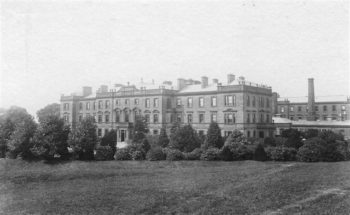
Richard Standish D’Ouseley, my stepmother Margo’s great-grandfather, was Collector of Customs in Douglas, Isle of Man, from 1861 to 1872. A prominent citizen in Douglas, Thomas Wilson, who had made his name and apparently a lot of money as a draper with several locations, was reportedly related to Richard D’Ouseley. From around 1860, Thomas Wilson and his family lived in Harold Tower, the 1833 “folly” pictured above. He leased it, presumably when he retired as a draper (in the 1861 census he is a “Retired Merchant” and doing rather well at age 55). For a few months in 1871, Thomas Wilson lived at the Crichton Royal Institution, Dumfries, a lunatic asylum, in a truly bizarre set of circumstances.
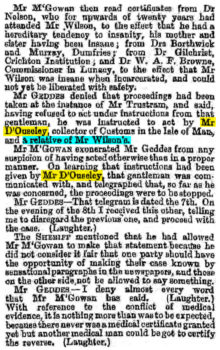
Once again, newspaper archives provide details of a story that official records don’t capture, but in trying to find the connection between Richard Standish D’Ouseley and Thomas Wilson, parish and census records provided information the newspapers didn’t. This excerpt is from one (of many from August and September 1871) story about Mr. Wilson’s attempts to petition for his release from the asylum. It was clearly the “right” Mr. D’Ouseley given other records placed him in the job of Collector of Customs in Douglas at that time, but there were no other people with a last name of Wilson in the family tree I had put together to date. I also didn’t realize that Harold Tower was a house – all the articles about “The Alleged Kidnapping of a Manx Gentleman” referred to “Mr Wilson of Harold Tower, Isle of Man”. I thought it was a village, initially.

Courtesy of Harold Tower being put on the market (for £3.95 million!) in early 2018, pictures of the castle on a hill showed up in a Google search. The castellated edge of the roof-top terrace is a bit much, but the view of the harbor is jaw-droppingly gorgeous, and it’s easy to see (a) how well Thomas Wilson did with his drapery businesses and (b) why he’d want to lease this as a retirement home. No other newspaper stories helped explain the connection between Wilson & D’Ouseley. But I should explain what happened to Thomas Wilson in July 1871.
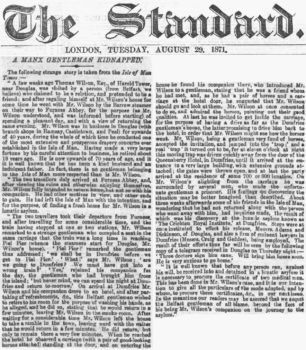 The British Newspaper Archive and Newspapers.com are both, unfortunately, missing the year 1871 from their records from the Isle of Man Times, however Mr. Wilson’s tale was sufficiently headline worthy that papers all over the country reprinted stories the Isle of Man Times ran. The very condensed version is that a man from Belfast befriended Thomas Wilson and talked him into a day trip to the mainland to see Furness Abbey. On the return train ride, Wilson noticed it was taking a long time to get back to Piel Pier and his companion said they were going to Dumfries (which would mean spending the night at a hotel there). Later that evening, a carriage arrived with horses Wilson admired, and on the pretext of taking him for a drive to see how well the horses handled, he was taken to the Crichton Royal Institute and incarcerated.
The British Newspaper Archive and Newspapers.com are both, unfortunately, missing the year 1871 from their records from the Isle of Man Times, however Mr. Wilson’s tale was sufficiently headline worthy that papers all over the country reprinted stories the Isle of Man Times ran. The very condensed version is that a man from Belfast befriended Thomas Wilson and talked him into a day trip to the mainland to see Furness Abbey. On the return train ride, Wilson noticed it was taking a long time to get back to Piel Pier and his companion said they were going to Dumfries (which would mean spending the night at a hotel there). Later that evening, a carriage arrived with horses Wilson admired, and on the pretext of taking him for a drive to see how well the horses handled, he was taken to the Crichton Royal Institute and incarcerated.
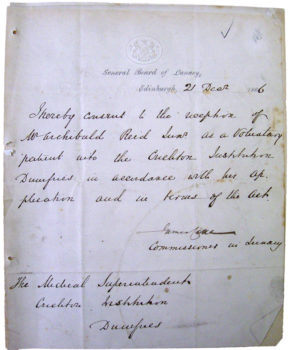
After friends in Douglas noticed Wilson hadn’t returned, inquiries were made leading to the discovery of what had happened and legal proceedings started to get Wilson released. In addition to getting some doctors to attest that he was sane, there were procedures to satisfy the General Board of Lunacy in Edinburgh and the Commissioner in Lunacy (look at the note from 1886; that’s really the title). The first legal attempt failed because apparently the law precluded the lunatic petitioning for his own release (and that’s a nightmare if all your relatives scheme to have you unfairly committed, but those were the rules at the time).
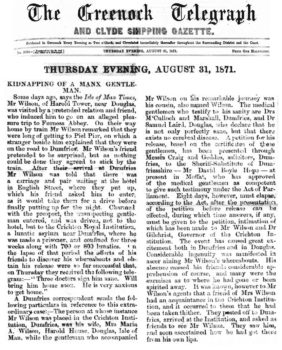
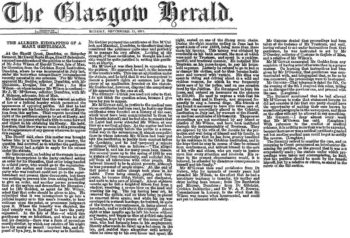
The story became even more headline-worthy when the legal proceedings continued and it became clear that Wilson’s wife, Maria Alice Wilson (née Thompson, born in Glasgow) was the one who had him committed! Her version of the story – that he’d been insane for years, had been despondent and was living at a nearby inn where he was spending money unwisely, egged on by the innkeeper. The harm to her and their daughters – presumably of financial loss – was her main concern. Friends on the Isle of Man knew that Mrs. Wilson knew people at Crichton which led them to find Mr. Wilson there. It seems to me the two stories are completely at odds – not like the he-said-she-said tales where you’re seeing two sides of one set of events. It doesn’t look good that Mrs. Wilson opposed having other doctors visit him at Crichton to assess him. And the institution has an incentive to please whoever is paying their bills (he was a private patient). Possibly this was a move to grab his money? Hard to say, although Wilson was released on September 21st as “recovered”.
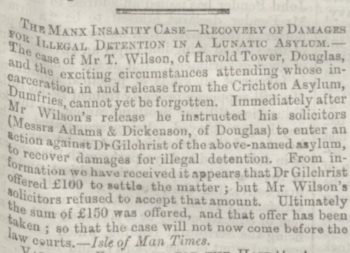
Following his release, Thomas Wilson sued Dr. Gilchrist for illegal detention and perhaps unfortunately, settled for £150 (about £16,500 today). I say unfortunately as we might have unearthed more details had there been legal proceedings. I wondered how things could possibly have been civil between Thomas and Maria Wilson after this episode, but there’s nothing in local papers to give a clue. In 1872 and 1874, Thomas Wilson is listed as a shareholder in The Isle of Man Banking Company Ltd, so he remained legally competent.
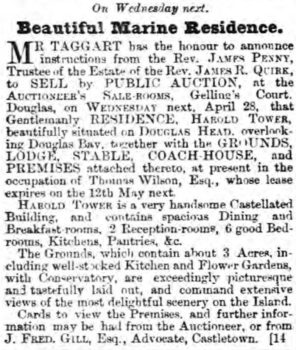
In 1875, notices appeared in the Isle of Man Times of an auction of Harold Tower – the owner wanted to sell when Wilson’s lease expired. Nothing like the wonderful pictures and web site the current sale has. Sadly, Thomas Wilson expired before his lease did – he died January 10, 1876 at Harold Tower.
Maria Alice Wilson lived until 1895 and left about £850,000 (in 2018 terms) with her daughter Charlotte as executor. She also collected (in 1877) £169 6s 9d from the Receiver-General of the Isle of Man as compensation for “injuries sustained by Mrs. Wilson during her tenancy of Harold Tower”. Would love to know what was alleged there.
Two remaining topics: the connection with Richard Standish D’Ouseley and the admission register for the Crichton Royal Institution including Thomas Wilson (I can’t believe that’s online, but the Wellcome Library has funded the records being digitized and put online). Here is a condensed version of the two-page register entries that makes it a little easier to read
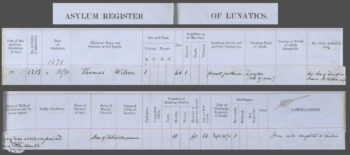
The connection. I had no Wilson family members in the existing family tree, but in trying to find Thomas Wilson’s baptism – he, like Richard Standish D’Ouseley, was born in Ireland – I came upon a parish register with a Thomas Wilson born about the right time (to match the census records) whose mother was Rose Callen. D’Ouseley’s mother was Brigid Callen. The two Callen women didn’t share fathers – so Thomas and Richard were not first cousins – but I posited that they may have shared grandfathers, which would make Thomas and Richard second cousins. The records get worse the farther back you go, so I don’t plan to try and follow this to be sure.
Possibly Thomas was looking for some family member to petition for his release and Richard’s standing – with a government post in the Customs Office – seemed helpful. The confusing telegrams Richard sent on September 7th & 8th suggest he wasn’t completely clear what he was doing – I would love to know more about that, but haven’t found additional stories so far. As to the cousin who accompanied Thomas home from Dumfries, along with one of Thomas’ daughters (probably the youngest, Maria Alicia Thompson Wilson, who was still living at home and unmarried), could it be the Wilson cousin who took him on the trip to Furness Abbey? It was never completely clear if the cousin was in on Mrs. Wilson’s plan for her husband. Or could it have been Richard Standish D’Ouseley?
Thomas Wilson must have been very happy to see the view from his sun terrace again (albeit without the modern furnishings).


